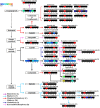Distinguishing Six Edible Berries Based on Metabolic Pathway and Bioactivity Correlations by Non-targeted Metabolite Profiling
- PMID: 30333849
- PMCID: PMC6175979
- DOI: 10.3389/fpls.2018.01462
Distinguishing Six Edible Berries Based on Metabolic Pathway and Bioactivity Correlations by Non-targeted Metabolite Profiling
Abstract
Berries have been used as valuable sources of polyphenols for human health; however, injudicious uses of berries are widespread without regard to the specific metabolite constituent of each berry. We classified 6 different edible berries (honeyberry, blueberry, mandarin melonberry, mulberry, chokeberry, and Korean black raspberry) based on their metabolite distributions in biosynthetic pathways by non-targeted metabolite profiling and bioactive correlation analysis. Principal component analysis revealed a distinct clustering pattern of metabolites for each berry. Metabolic pathway analysis revealed different biosynthetic routes of secondary metabolites in each berry. Mandarin melonberry contains a relatively higher proportion of genistein, genistein glycoside, and genistein-derived isoflavonoids and prenylflavonoids than the other berries. Various anthocyanin glycosides, synthesized from dihydroquercetin and cyanidin, were more abundant in chokeberry and honeyberry, whereas high levels of flavonoid-and anthocyanins-rutinoside forms were observed in Korean black raspberry. The levels of anthocyanins derived from dihydromyricetin were high in blueberry. The highest anti-oxidant activity was observed in chokeberry and Korean black raspberry, which is positively related to the proportional concentration of flavonoids, phenolics, and anthocyanins. The lowest sugar contents were observed in Korean black raspberry, highest acidity in honeyberry, and lowest acidity in mandarin melonberry, which were specific characteristics among the berries. Taken together, biosynthetic pathway and physicochemical characteristics analyses revealed that the different synthesized routes of flavonoids and anthocyanins and associated bio-activities may be distinct features in each berry and explain their phenotypic diversity at the molecular level.
Keywords: anti-oxidant activity; berry; biosynthetic pathway; metabolomics; polyphenol.
Figures




Similar articles
-
Anthocyanin Profile and Antioxidant Activity of Various Berries Cultivated in Korea.Nat Prod Commun. 2015 Jun;10(6):963-8. Nat Prod Commun. 2015. PMID: 26197528
-
Saskatoon and wild blueberries have higher anthocyanin contents than other Manitoba berries.J Agric Food Chem. 2007 Dec 26;55(26):10832-8. doi: 10.1021/jf072529m. Epub 2007 Dec 5. J Agric Food Chem. 2007. PMID: 18052240
-
Phytochemical properties and antioxidant capacities of various colored berries.J Sci Food Agric. 2014 Jan 30;94(2):180-8. doi: 10.1002/jsfa.6216. Epub 2013 Jul 4. J Sci Food Agric. 2014. PMID: 23653223
-
Berry derived constituents in suppressing viral infection: Potential avenues for viral pandemic management.Clin Nutr ESPEN. 2021 Dec;46:14-20. doi: 10.1016/j.clnesp.2021.09.728. Epub 2021 Sep 28. Clin Nutr ESPEN. 2021. PMID: 34857187 Review.
-
On the Developmental and Environmental Regulation of Secondary Metabolism in Vaccinium spp. Berries.Front Plant Sci. 2016 May 18;7:655. doi: 10.3389/fpls.2016.00655. eCollection 2016. Front Plant Sci. 2016. PMID: 27242856 Free PMC article. Review.
Cited by
-
Multivitamin and Mineral Supplementation Containing Phytonutrients Scavenges Reactive Oxygen Species in Healthy Subjects: A Randomized, Double-Blinded, Placebo-Controlled Trial.Nutrients. 2019 Jan 5;11(1):101. doi: 10.3390/nu11010101. Nutrients. 2019. PMID: 30621298 Free PMC article. Clinical Trial.
-
Physicochemical characteristics and consumer acceptance of puddings fortified with Cudrania tricuspidata and Aronia melanocarpa extracts.Food Sci Nutr. 2020 Jul 21;8(9):4936-4943. doi: 10.1002/fsn3.1790. eCollection 2020 Sep. Food Sci Nutr. 2020. PMID: 32994955 Free PMC article.
-
Comparative Metabolomics Unravel the Effect of Magnesium Oversupply on Tomato Fruit Quality and Associated Plant Metabolism.Metabolites. 2019 Oct 16;9(10):231. doi: 10.3390/metabo9100231. Metabolites. 2019. PMID: 31623116 Free PMC article.
-
Combined transcriptomic and metabolic analyses reveal potential mechanism for fruit development and quality control of Chinese raspberry (Rubus chingii Hu).Plant Cell Rep. 2021 Oct;40(10):1923-1946. doi: 10.1007/s00299-021-02758-6. Epub 2021 Jul 31. Plant Cell Rep. 2021. PMID: 34333679
-
Comparison of fruit morphology and nutrition metabolism in different cultivars of kiwifruit across developmental stages.PeerJ. 2021 Jun 23;9:e11538. doi: 10.7717/peerj.11538. eCollection 2021. PeerJ. 2021. PMID: 34221713 Free PMC article.
References
-
- Ancillotti C., Ciofi L., Pucci D., Sagona E., Giordani E., Biricolti S., et al. (2016). Polyphenolic profiles and antioxidant and antiradical activity of Italian berries from Vaccinium myrtillus L. and Vaccinium uliginosum L. subsp. gaultherioides (Bigelow) S.B. Young. Food chem. 204, 176–184. 10.1016/j.foodchem.2016.02.106 - DOI - PubMed
-
- Castrejón A. D. R., Eichholz I., Rohn S., Kroh L. W., Huyskens-Keil S. (2008). Phenolic profile and antioxidant activity of highbush blueberry (Vaccinium corymbosum L.) during fruit maturation and ripening. Food Chem. 109, 564–572. 10.1016/j.foodchem.2008.01.007 - DOI
-
- Choi I. S., Kwak E. J. (2014). Comparison of antioxidant activities and bioactive compounds between Bokbunja (Rubus coreanus Miq.) and other berries. Food Sci. Biotechnol. 23, 1677–1682. 10.1007/s10068-014-0228-8 - DOI
LinkOut - more resources
Full Text Sources

